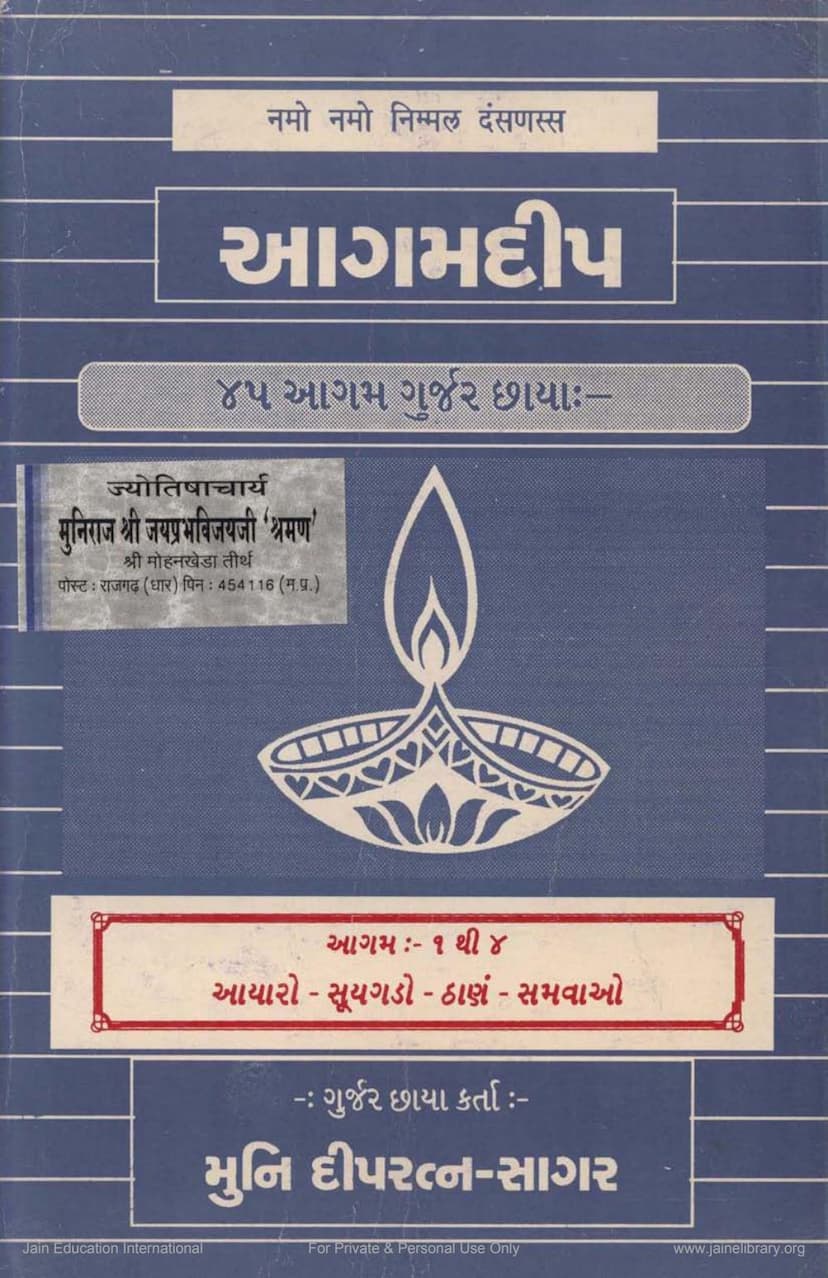Agam Deep 03 Thanam Gujarati Anuvaad
Added to library: September 1, 2025

Summary
The provided text is a Gujarati translation and commentary titled "Agam Deep 03 Thanam Gujarati Anuvaad" (meaning "Agam Deep 03 Thanam Gujarati Translation"), authored by Dipratnasagar and Deepratnasagar, and published by Agam Shrut Prakashan. The catalog link points to JainQQ.org. The text focuses on the Jain Agama text "Sthananga Sutra" (referred to as "Thanam" or "Sthan").
Here's a breakdown of the content based on the provided pages:
Core Content:
- Focus on Sthananga Sutra: The text is a detailed explanation and translation of the Sthananga Sutra, one of the fundamental Agamas of Jainism. The Sthananga Sutra is known for its systematic classification of spiritual and worldly concepts based on numerical categories (e.g., things that exist in ones, twos, threes, etc.).
- Gujarati Translation and Commentary: The title indicates it's a Gujarati translation ("Gujarati Anuvaad") with a commentary or explanation ("Deep"). The phrase "Gurjar Chhaya" by Muni Deepratna-Sagar suggests a commentary in the Gujarati language.
- Numerical Categorization (Ek, Dvi, Tri, etc.): The content extensively details various categories, listing entities, principles, or concepts that fall under specific numbers (one, two, three, four, five, six, seven, eight, nine, ten, etc.). This is the primary method of organization within the Sthananga Sutra.
- Broad Scope of Jain Philosophy: The Sthananga Sutra, and therefore this translation, covers a vast range of Jain philosophical topics. This includes:
- Ontology and Cosmology: Descriptions of the universe, its components (like soul, non-soul, space, time), the nature of reality.
- Soteriology and Ethics: Concepts related to liberation, karmic bondage, the path to spiritual advancement, virtues, vows, and ethical conduct.
- Psychology and Consciousness: The workings of the mind, senses, knowledge, and different states of consciousness.
- Jain Practices and Life: Ascetic practices, conduct of monks and nuns, different types of souls, and aspects of Jain cosmology.
- Specific Examples: The text provides numerous examples within each numerical category, illustrating abstract concepts with concrete instances from Jain tradition and scripture.
Key Themes and Structures:
- Systematic Classification: The entire work is built on the principle of classifying phenomena according to numbers, starting from 'one' and progressing upwards.
- "Ek", "Dvi", "Tri", "Chatuh", "Panch", "Shat", "Sapta", "Ashta", "Nava", "Dash" etc.: The pages repeatedly mention these numerical categories, followed by lists of items belonging to them. For example, "Ek" might be followed by lists of things that are singular, "Dvi" by things that come in pairs, "Tri" by triads, and so on.
- Detailed Exploration of Categories: The text appears to be a very exhaustive exploration of the Sthananga Sutra's classifications. For instance, the numbering within the text (e.g., [1], [2], [3] etc.) seems to correspond to specific points or classifications within the Sthananga Sutra.
- Devotional Elements: The initial pages contain invocations ("Namo Namo Nirmal Desanss," "Nemo Nemo Nirmal Dassanss," "Om Hrim Aham Shri Parshwanathay Namah") and dedications to spiritual teachers and patrons, which is common in religious texts.
- Sponsorship and Publication Details: Pages 3, 5, and 6 list the patrons and contributors to the publication, indicating the significant effort and community involvement in bringing this work to light. This also highlights the value placed on such detailed scriptural works.
- Cataloging and References: The inclusion of page numbers, references to different Angas (like Ayaro, Suyagado, Thanu, Samavayo), and the structure of the Sthananga Sutra (listing its chapters or sections) is evident.
- Linguistic Nature: The translation is in Gujarati, aiming to make these profound Jain scriptures accessible to the Gujarati-speaking community.
In essence, this text is a comprehensive Gujarati translation and scholarly explanation of the Sthananga Sutra, a foundational Jain Agama that classifies spiritual and worldly phenomena through numerical enumeration. It's a work of deep learning and devotion, dedicated to making these complex teachings understandable to a wider audience.